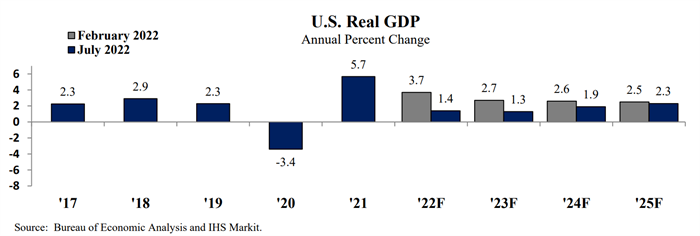The state of Minnesota’s revenue picture for FY 2022 remains solid, but the national economic recovery is expected to be much weaker, according to the J
uly Revenue and Economic Update from Minnesota Management and Budget (MMB).
Some of the top takeaways from the Update include:
1.
Nationally, economic growth is still expected in 2022 and beyond, but much weaker than earlier predicted. Forecasters now predict 1.4 percent GDP growth in 2022, less than half of the 3.7 percent predicted in the February forecast. This decrease is in part due to Russia’s invasion of Ukraine, which among other impacts, has contributed to increased food and energy prices and slow global economic growth. Looking to the next few years, economic growth is expected to remain quite low, staying below 2 percent until 2025. With such low economic growth, state forecasters have noted the increased risk of a recession in the next year.

2.
State fiscal year 2022 revenues came in higher compared to the February forecast. Revenues for Minnesota’s FY 2022, which ended on June 30, came in $2.9 billion or 10.7 percent higher than February projections. Individual income tax revenue was the largest source of this increase, but MMB notes that much of the higher-than-expected revenues are due to timing issues rather than reflecting stronger economic fundamentals.
3.
Official unemployment rate is low. In June, the national unemployment rate was 3.6 percent. This unemployment rate is just 0.1 percentage points above the February 2020 pre-pandemic level. In addition, many workers who left the workforce earlier in the pandemic continue to re-enter the workforce, but the national labor force participation rate is still lower than it was in February 2020.
Our take on what this means
While state revenues continue to out-perform earlier expectations, we haven’t yet reached a broad-based recovery. Many Minnesotans are still struggling, and the pandemic and recession’s unequal impact won’t be eliminated without further action from policymakers. This spring, 121,000 Minnesota adults said they couldn’t afford to give their kids enough to eat, 98,000 Minnesotans were behind on rent, and 1.1 million were having trouble covering basic household expenses.
With a historic projected surplus of $9.3 billion in FY 2022-23, this past legislative session policymakers had an opportunity to make transformative investments to address the real challenges that Minnesotans are facing and build a stronger, more equitable recovery. But
after the 2022 Legislative Session, much of that work remains unfinished.
There are still about six months until the 2023 Legislative Session, where it is likely that policymakers will again see a budget surplus and have another opportunity to meet the urgent needs of Minnesotans.
Minnesotans will need bold policy action, particularly to support lower-income and Black, Indigenous, and other Minnesotans of Color who have struggled disproportionately during the pandemic and under the unequal status quo that predated it.